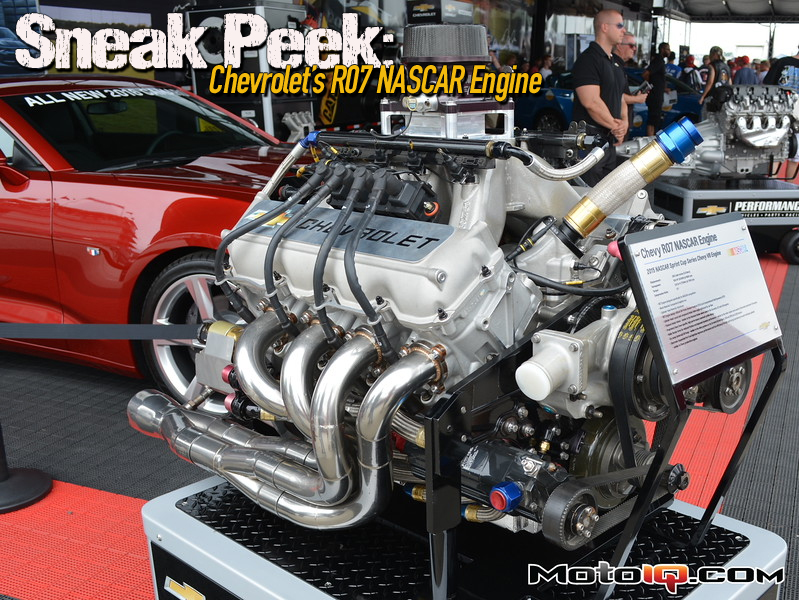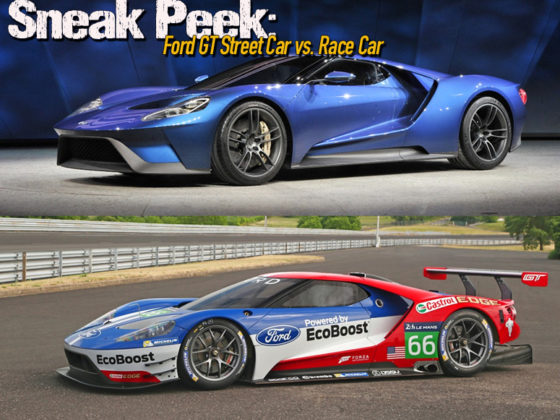,
 Yes you are right, this is actually a Toyota engine, but it is the same generation as the R07 and was a cutaway. You can see that Toyota has filled the heads with rockers, pushrods, and valves and there is simply no room for spark plugs. Since these engines are not mass produced, Toyota (as well as Chevrolet and Ford) can take the time to CAD-CAM machine the passages for pushrods and rockers at odd angles. This allows for the biggest valves the engine designers can cram into the head. This also allows for the largest possible rockers, which can allow for more lift on the valves without using too large a camshaft. Unfortunately, all of this valve gear crammed up here means the plugs end up getting shuffled around to the outside of the engine. This does allow the engine designers to place the electrode in an ideal location, creating the best burn pattern and making the most of the air and fuel being sucked in through the intake. Finally, the use of CAD-CAM machining allows for the intake and exhaust ports to be as straight as possible. In mass produced engines, the pushrod placement takes precedence since reaming them to size is a post-casting process. Putting them in a simple 2-dimensional grid allows for quick machining to lower costs. Once again, power takes precedence over cost and the cost of using a 5-axis mill to ream oddly angled pushrods is worth it to teams squeezing out every ounce of power. As a final note on the heads, Chevrolet sends out the head castings with unmachined ports. The teams (or their engine builders) do final porting themselves to get the exact specs they want using their own cylinder head voodoo. The pistons are high domed to extract the maximum 12.0:1 compression NASCAR limits engines to.
Yes you are right, this is actually a Toyota engine, but it is the same generation as the R07 and was a cutaway. You can see that Toyota has filled the heads with rockers, pushrods, and valves and there is simply no room for spark plugs. Since these engines are not mass produced, Toyota (as well as Chevrolet and Ford) can take the time to CAD-CAM machine the passages for pushrods and rockers at odd angles. This allows for the biggest valves the engine designers can cram into the head. This also allows for the largest possible rockers, which can allow for more lift on the valves without using too large a camshaft. Unfortunately, all of this valve gear crammed up here means the plugs end up getting shuffled around to the outside of the engine. This does allow the engine designers to place the electrode in an ideal location, creating the best burn pattern and making the most of the air and fuel being sucked in through the intake. Finally, the use of CAD-CAM machining allows for the intake and exhaust ports to be as straight as possible. In mass produced engines, the pushrod placement takes precedence since reaming them to size is a post-casting process. Putting them in a simple 2-dimensional grid allows for quick machining to lower costs. Once again, power takes precedence over cost and the cost of using a 5-axis mill to ream oddly angled pushrods is worth it to teams squeezing out every ounce of power. As a final note on the heads, Chevrolet sends out the head castings with unmachined ports. The teams (or their engine builders) do final porting themselves to get the exact specs they want using their own cylinder head voodoo. The pistons are high domed to extract the maximum 12.0:1 compression NASCAR limits engines to. Moving back to the Chevy engine, we get a better view of the dry sump and water pump. The water pump is massive, looking like a small turbocharger. Airflow is very limited through a NASCAR engine bay, so water flow is hugely important. Teams will seal off as much of the limited grille openings as possible to lower drag and improve downforce. Therefore, making sure the water circulates consistently is very important. Looking at the headers, each flange is super beefy and retained with 12-point fasteners (which are likely safety wired when the engine is installed in the car). The headers are a work of art and beautifully welded. Lots of little details set apart a top tier NASCAR engine from the SBC you'll find in a junkyard. Details like the plug wire retainers that ensure the wires do not accidentally touch the red hot headers and melt.
Moving back to the Chevy engine, we get a better view of the dry sump and water pump. The water pump is massive, looking like a small turbocharger. Airflow is very limited through a NASCAR engine bay, so water flow is hugely important. Teams will seal off as much of the limited grille openings as possible to lower drag and improve downforce. Therefore, making sure the water circulates consistently is very important. Looking at the headers, each flange is super beefy and retained with 12-point fasteners (which are likely safety wired when the engine is installed in the car). The headers are a work of art and beautifully welded. Lots of little details set apart a top tier NASCAR engine from the SBC you'll find in a junkyard. Details like the plug wire retainers that ensure the wires do not accidentally touch the red hot headers and melt. On the back side of the engine, we can see the huge braided lines coming out of the oil sump and leading to the in-car mounted oil tank. We also get a good look at the 4-2-1 headers, drafted in polished stainless steel. The primaries are very long, once again for high RPM breathing. We suspect a shorter primary header would be used at short tracks. NASCAR teams have entire cars built specifically for each type of track, so tuning the engine's powerband accordingly would fit right into that world of optimization. On the back side of the engine, you can also see the FPR controlling fuel flow to the rails. NASCAR uses a return style fuel system for their engines.
On the back side of the engine, we can see the huge braided lines coming out of the oil sump and leading to the in-car mounted oil tank. We also get a good look at the 4-2-1 headers, drafted in polished stainless steel. The primaries are very long, once again for high RPM breathing. We suspect a shorter primary header would be used at short tracks. NASCAR teams have entire cars built specifically for each type of track, so tuning the engine's powerband accordingly would fit right into that world of optimization. On the back side of the engine, you can also see the FPR controlling fuel flow to the rails. NASCAR uses a return style fuel system for their engines. A close up of the headers. The welds are perfect. Yes, NASCAR may use some very archaic technology and yes, the racing can resemble the WWE at times (both on the track and off), but you have to admire the skills of the men and women who build these cars. Unlike open wheel racing, every single NASCAR is hand built from the ground up. Another neat detail of the engine here is the machined mounting plate for the oil lines. Not only was this engine designed for maximum horsepower, but it was designed for easy maintenance. Looking through our other pictures you can see how all of the plumbing and wiring terminates easily at the firewall so engine changes can be done quickly. Even notice how the bellhousing is designed to come away with the engine. This means the clutch does not have to be removed and realigned when swapping engines. Neat!
A close up of the headers. The welds are perfect. Yes, NASCAR may use some very archaic technology and yes, the racing can resemble the WWE at times (both on the track and off), but you have to admire the skills of the men and women who build these cars. Unlike open wheel racing, every single NASCAR is hand built from the ground up. Another neat detail of the engine here is the machined mounting plate for the oil lines. Not only was this engine designed for maximum horsepower, but it was designed for easy maintenance. Looking through our other pictures you can see how all of the plumbing and wiring terminates easily at the firewall so engine changes can be done quickly. Even notice how the bellhousing is designed to come away with the engine. This means the clutch does not have to be removed and realigned when swapping engines. Neat! Here is a view of the engine bay wiring harness. It's very bare-bones, but it is designed that way. NASCAR does allow data logging with the EFI, but carefully restricts the data teams can capture. Once again, the work here is state of the art: mil-spec connectors, wiring, and shrink tube. Here, the connectors are mounted to a metal plate for display purposes. In the car, these would connect directly to bulkhead connectors on the firewall. You can even see some of the wiring labels on individual plugs. Very tidy and simple, but dead reliable, just as you would expect a racing engine to be.
Here is a view of the engine bay wiring harness. It's very bare-bones, but it is designed that way. NASCAR does allow data logging with the EFI, but carefully restricts the data teams can capture. Once again, the work here is state of the art: mil-spec connectors, wiring, and shrink tube. Here, the connectors are mounted to a metal plate for display purposes. In the car, these would connect directly to bulkhead connectors on the firewall. You can even see some of the wiring labels on individual plugs. Very tidy and simple, but dead reliable, just as you would expect a racing engine to be.Are these engines a bit dated for today's racing? Yes, but the fans do not care: NASCAR's carefully controlled formula produces great racing that is still number 1 in America. It's very interesting to see the amount of effort OEMs and team go through to ensure they have that little edge that puts them in victory lane. Chevrolet has been successful too: the R07 won its first 12 outings in a row and has won all but one Sprint Cup Championship since its debut. Used R07s are available, though hard to come by. Used SB1s and 2s can be had at reasonable prices and make lots of power. Used NASCAR engines are slowly trickling into drift cars and for good reason: out of the box these make over 800 horsepower and have the potential for far more before you add forced induction. Ironically, Formula Drift cars are now much more powerful than NASCARs, so if anything maybe Jeff Gordon should grab a spare engine from Dai Yoshihara and win a few races in his last year!



